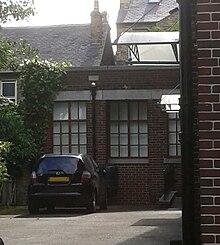
Bevis Marks Synagogue, officially Qahal Kadosh Sha'ar ha-Shamayim, is an Orthodox Jewish congregation and synagogue, located off Bevis Marks, Aldgate, in the City of London, England, in the United Kingdom. The congregation is affiliated to London's historic Spanish and Portuguese Jewish community and worships in the Sephardic rite.

The Singers Hill Synagogue, officially the Birmingham Hebrew Congregation, is an Orthodox Jewish congregation and synagogue, located at 26, 26A and 26B Blucher Street, in the Birmingham city centre, in the West Midlands of England, in the United Kingdom. The congregation dates from 1780 and worshiped in the Ashkenazi rite.
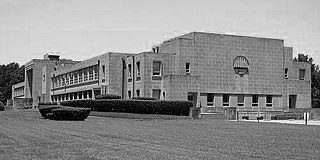
The Baron Hirsch Synagogue, is an Modern Orthodox Jewish congregation and synagogue located at 400 South Yates Road, Memphis, Tennessee, in the United States. Founded in c. 1862 – c. 1864, the congregation underwent tremendous growth in the first half of the 20th century, emerging, in the 1950s, as the largest Orthodox congregation in North America, a position it still holds.
The Cardiff United Synagogue, also called the Cardiff Shul, is an Orothodox Jewish synagogue, located in Cyncoed Gardens, in the Cyncoed suburb of Cardiff, Wales, in the United Kingdom.

The Northern School of Contemporary Dance (NSCD) is a higher education institution in Chapeltown, Leeds, England specialising in contemporary dance. Students can obtain undergraduate and postgraduate degrees in dance, validated by the University of Kent. A programme of adult, youth and children's classes is also available for the local community. Its buildings include the grade II listed former New Synagogue.
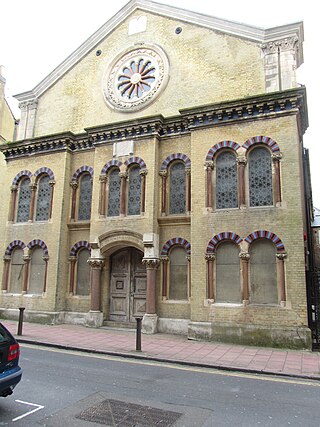
The Middle Street Synagogue is a synagogue in the centre of Brighton, part of the English city of Brighton and Hove. It was the centre for Jewish worship in Brighton and Hove for more than a century. Although it is not in full-time use, the building is still open at certain times, and cultural events frequently take place, as do weddings. It has been listed at Grade II*, reflecting its architectural and historic importance.

The Sunderland Synagogue is a former Orthodox Jewish congregation and synagogue, located on Ryhope Road, in Sunderland, Tyne and Wear, England, in the United Kingdom. The congregation was formed as the Sunderland Hebrew Congregation in 1861 and worshiped in the Ashkenazi rite until the congregation was dissolved in 2006.

Jesmond Synagogue, now known as Byzantine House, is a former Orthodox Jewish congregation and synagogue, located on Eskdale Terrace, in the Jesmond neighbourhood of Newcastle upon Tyne, in northeast England, in the United Kingdom. Established in 1914, the congregation worshiped in the Ashkenazi rite, until its closure in 1986.
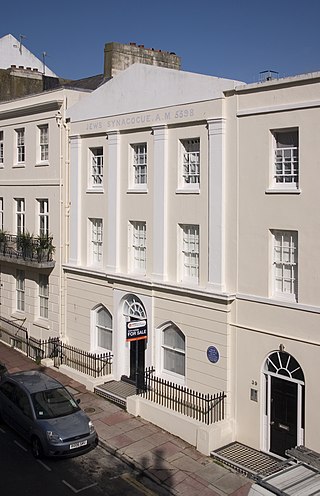
The Brighton Regency Synagogue, also called the Devonshire Place Synagogue, is a former Orthodox Jewish congregation and synagogue, located at 38–39 Devonshire Place, Kemptown, Brighton and Hove, in East Sussex, England, in the United Kingdom. The congregation, established in 1824, worshiped in the Ashkenazi rite.

Sandy's Row Synagogue is an Orthodox Jewish congregation and synagogue, located on Sandys Row, on the corner of Middlesex Street in Bishopsgate, in the East End, Borough of Tower Hamlets, London, England, in the United Kingdom.

Congregation Ahavath Achim is a Modern Orthodox Jewish congregation and synagogue, located in Fairfield, Connecticut, in the United States.
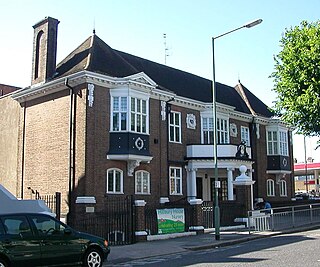
Ralli Hall is a community centre, events venue, theatre stage, business hub and impressive main hall in Hove, part of the English coastal city of Brighton and Hove. Built in 1913 as a memorial to Stephen Ralli, a member of a wealthy Greek family who had donated money to many causes throughout Brighton and Hove, it was used for about 60 years as a church hall linked to Hove's parish church. The Brighton & Hove Jewish community subsequently bought it, and in 1976 it came back into use as a community and social centre for Jewish and other groups. The Wrenaissance-style brick structure occupies a prominent corner site in a conservation area and provides a visual contrast to the older villas around it. English Heritage has listed the building at Grade II for its architectural and historical importance.

Bugby Chapel is an 18th-century former chapel in the centre of Epsom, a suburban town in Surrey, England. Known by this name in reference to its Calvinistic founder William Bugby, it was also known as East Street Chapel and later, as it passed into the ownership of different religious groups, as Salem Unitarian Chapel, Salem Baptist Chapel and the Epsom and District Synagogue. More than 200 years of religious use ended when it was converted into an office. The chapel is a Grade II Listed building.

The Brisbane Synagogue is a heritage-listed synagogue at 98 Margaret Street, Brisbane City, City of Brisbane, Queensland, Australia. It was designed by Arthur Morry and built from 1885 to 1886 by Arthur Midson. It was added to the Queensland Heritage Register on 21 October 1992.
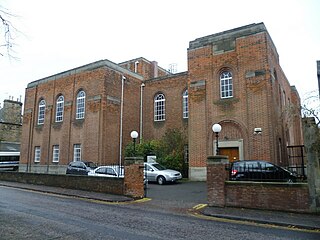
The Edinburgh Synagogue is an Orthodox Jewish congregation and synagogue, located at 4 Salisbury Road in the Newington area of Edinburgh, Scotland, in the United Kingdom. Established in 1816 as the Edinburgh Hebrew Congregation, the congregation worships in the Ashkenazi rite.

Meadrow Unitarian Chapel is a Unitarian chapel in the Farncombe area of Godalming, Surrey, England. It is part of the London District and South Eastern Provincial Assembly of Unitarian and Free Christian Churches, one of 16 districts within the General Assembly of Unitarian and Free Christian Churches, the umbrella organisation for British Unitarians.

The Langside Synagogue is a former Orthodox Jewish synagogue, located near Govanhill in Glasgow, Scotland. It opened in May 1927 and closed in 2014. Whilst active, the congregation worshiped in the Ashkenazi rite.


